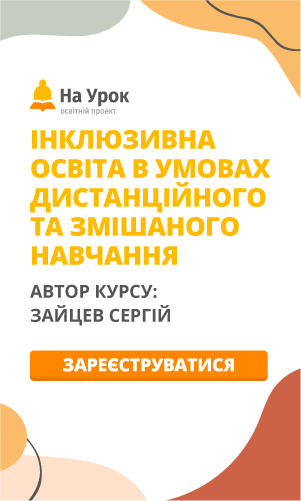"You are what you eat" ("Ви є те, що ви їсте") - конспект уроку
Тема уроку – «Традиційні страви». Урок є особистісно-орієнтованим із врахуванням вікових та індивідуальних особливостей дітей із застосуванням здоров'язберігаючих технологій. Учням пропонуються обмінятися інформацією про улюблені страви, дізнатися про здорове харчування.
Загальноосвітня мета: розширювати знання учнів про групи продуктів, про особливості вживання структури “used to"
Практична мета: навчити учнів обмінюватися інформацією про улюблені страви; навчити вживати конструкцію “used to" у мовленні
Розвиваюча мета: розвивати комунікативні здібності учнів, закріпити вивчений лексичний матеріал на письмі; сприяти розвитку логічного мислення, розвивати мовну здогадку та вміння аудіювати текст, що містить незначну частину невідомих слів, уяву учнів в умовах рольової гри
Виховний вплив: виховувати в учнів культуру харчування як складової здорового способу життя
Тип уроку: формування умінь та навичок
Тема: You are what you eat. Ви є те, що ви їсте.
Загальноосвітня мета: розширювати знання учнів про групи продуктів, про особливості вживання структури “used to”
Практична мета: навчити учнів обмінюватися інформацією про улюблені страви; навчити вживати конструкцію “used to” у мовленні
Розвиваюча мета: розвивати комунікативні здібності учнів, закріпити вивчений лексичний матеріал на письмі; сприяти розвитку логічного мислення, розвивати мовну здогадку та вміння аудіювати текст, що містить незначну частину невідомих слів, уяву учнів в умовах рольової гри
Виховний вплив: виховувати в учнів культуру харчування як складової здорового способу життя
Тип уроку: формування умінь та навичок
Обладнання: підручник англійської мови, картинки із зображенням продуктів харчування, відеозапис фізкультхвилинки, скоромовок, аудіо запис пісні “Give me the Food”, мультимедійна презентація
Хід уроку.
І. Організація навчальної діяльності
1. Привітання
Teacher: Good morning, dear pupils. I’m glad to see you today. I hope that you feel fine and ready to start our lesson.
2. Повідомлення теми, мети уроку
Teacher: The theme of our today’s lesson is “You are what you eat”, we continue to learn these theme and our aim is to revise the lexical and grammar material studied on the previous lessons. You’ll practise listening and reading comprehension, and making up dialogues on the topic given.
3. Уведення до іншомовного середовища
Teacher: Let’s begin our lesson from reading two tongue twisters and revising the sounds [f] and [p]: Friends fed Fred fried food from Franks
Peter Piper picked a peck of pickled peppers.
Did Peter Piper pick a peck of pickled peppers?
If Peter Piper picked a peck of pickled peppers,
Where’s the peck of pickled peppers Peter Piper picked?
Teacher: You know, that English language is rich in proverbs. And there are lots of proverbs connected with food. Let’s revise some of them. Now listen to me, I’m going to tell you the meaning of some of the proverbs and you’ll try to guess them:
- If we are told, that we are not allowed to have something, we want it more than ever. (Forbidden fruit is sweet)
- We all have our likes and dislikes. No two people have the same likes and dislikes, or do things in the same way, so it is a waste of time to argue about it. (Tastes differ)
- You shouldn’t satisfy only your physical needs. There are many more important things in your life to be happy: love, friendship, happiness, excitement, etc. (Man does not live by bread alone)
- Having something today is better than having nothing and waiting for something wonderful (Bread today is better than cake tomorrow)
Teacher: Let’s continue revising the proverbs. Now we’ll do another task: some pupils will get cards with the first part of the proverb, others will have the ending. Let’s match these parts:
|
An apple a day |
keeps a doctor away. |
|
Appetite comes |
with eating. |
|
Hungry belly |
has no ears. |
|
Too many cooks |
spoil the broth. |
|
Never fry a fish |
before it is caught. |
|
Eat to live |
not live to eat. |
ІІІ. Актуалізація лексичного матеріалу
Speaking
Teacher: And now let’s speak about food. Look at the screen. There are questions with mixed words. Your task is to put the words into the correct order and make up questions. Ask each other these questions:
- of * you * fond * are * cooking? (Are you fond of cooking?)
- breakfast * your * in * family * who * cooks? (Who cooks breakfast in your family?)
- often * you * eat * food * junk * do? (Do you often eat junk food?)
- for * you * lunch * what * to have * like * would? (What would you like to have for lunch?)
- the best * cuisine * is * Ukrainian? (Is Ukrainian cuisine the best?)
Teacher: Look! I have a magic box, there is something in it. Try to guess what it is.
- Is it a fruit (vegetable)?
- Is it big (small)?
- Is it round (square, oval)?
- Is it long (short)?
- Is it spicy (bitter, sour)?
- Is it tasty (tasteless)?
- Is it good for our health?
- Is it red (yellow, green)?
- Can we use it to prepare salad (soup)?
- Does it grow in Ukraine?
Yes, you’re right, it’s a cabbage.
Which traditional Ukrainian dishes can we cook using this vegetable?
IV. Контроль домашнього завдання
1. Розповідь учнів про традиційні страви в Україні
2. Розповідь учнів про прийом їжі у Великобританії.
V. Основна частина уроку
1. Повторення лексичного матеріалу
- Розвиток навичок читання.
Pre reading tasks: conversation
Teacher: Are there any dishes you can cook?
Picture description, p.117: Open your books on p.117. What kind of dish can you see? Is it tasty? Can you cook it? Let’s read the directions of Greek salad preparation.
- Teacher: Now imagine that you are chefs. What can you do with food products? Look at the screen, these pictures will help you. (One pupil comes to the blackboard to write the verbs denoting actions done with food)
Verbs: cut, chop, add, slice, wash, peel, pour, enjoy, squeeze, chop, mix
- Well done. And now let’s prepare vegetable salad. Look at the board. You can see the recipe, but the verbs are missing. You should fill in the missing verbs.
- wash the vegetables
- peel onion, wash it
- slice cucumbers
- cut tomatoes
- chop onion
- chop parsley
- add some salt and pepper
- pour some oil
- squeeze some lemon juice
- mix the salad
- enjoy your meal!
2. Розвиток навичок мовлення
Teacher: I see that you’re good cooks. And I know that some pupils would like to demonstrate us their cooking talents. Let’s see their works.
(Учні представляють свої роботи про приготування страв)
ФІЗКУЛЬТХВИЛИНКА (“Go, bananas”)
3. Повторення граматичного матеріалу
1. Правило вживання конструкції “used to”: Look at the board. Let’s revise the rule of using construction “used to”. Fill in the missing expressions in the rule.
2. Приклади вживання конструкції “used to”: Read the following sentences. In which sentence the construction is used for something that was true and for denoting an action that happened regularly in the past?
3. Коли ми не вживаємо дану граматичну структуру?
We _________ “used to” for actions that happened only once. (DON’T USE)
4. Розглянути приклади стверджувального, заперечного та питального речень з даною конструкцією.
5. Виконання тренувальних вправ
- Look at the following pictures of celebrities and say:
What did the celebrities use to do in the past? What do they do nowadays?
- And what about you? What did you use to eat in your childhood? (З допомогою картинок, які показує вчитель, учні задають один одному запитання про страви, які вони регулярно їли у дитинстві)
- Open the brackets and write the correct form of the verb or construction “used to”.
4. Розвиток навичок читання
Teacher: We have already spoken about Ukrainian and British food. And what can you say about American food? What famous American dishes do you know? Let’s read the text about American food on p.216
Post reading activities: choose the correct answer
1. Where do most Americans eat?
a) at work
b) at home
c) in restaurants
d) in the street
2. Which kind of food do they sell in fast food restaurants?
a) healthy
b) expensive
c) home made
d) junk
3. What do they eat for breakfast?
a) meat and vegetables
b) flakes or eggs
c) sandwich or salad
d) biscuits and coffee
4. What is the substantial meal of the day?
a) breakfast
b) lunch
c) dinner
d) supper
5. What do they eat with ketchup or cream for dinner?
a) pasta
b) fish
c) meat
d) potatoes
Answer the questions:
- What do Americans have for breakfast (lunch, dinner)?
- What kind of restaurant did they found?
- Do you like eating in fast food restaurants?
- Do you agree that dishes in fast food restaurants are not good for your health?
Розвиток навичок мовлення.
Teacher: Now let’s divide into two groups. The first group should speak about the advantages and the second group about the disadvantages of fast food restaurants.
Possible answers
|
advantages |
disadvantages |
|
Cheap |
Low quality |
|
Time saving |
Junk, unhealthy |
|
Delicious |
Homemade food is cheaper |
|
You can choose healthy food in the menu |
Has much sugar and little fruit |
Teacher: What would you advise to people who want to be healthy?
1. Eat more fruits and vegetables
2. Go in for sport
3. Eat dairy products
4. Eat fish and meat
5. Don’t eat fried food
6. Cook food yourself
5. Розвиток навичок аудіювання
Teacher: Listen to the song “Give me the food” and do the tasks.
VI. Підсумок уроку, оцінювання знань учнів
VII. Д/з – переказ тексту про американську їжу
|
An apple a day
|
keeps a doctor away.
|
|
Appetite comes
|
with eating.
|
|
Hungry belly
|
has no ears. |
|
Too many cooks
|
spoil the broth. |
|
Never fry a fish
|
before it is caught. |
|
Eat to live
|
not live to eat. |


про публікацію авторської розробки
Додати розробку
